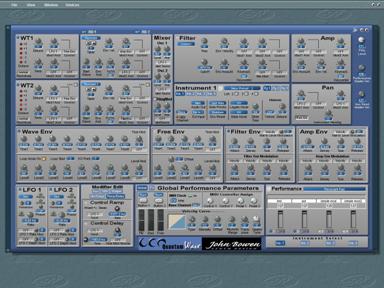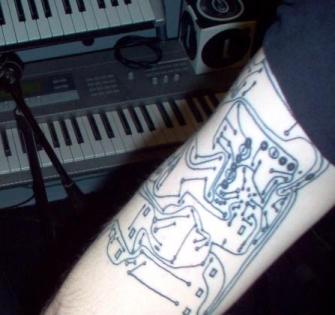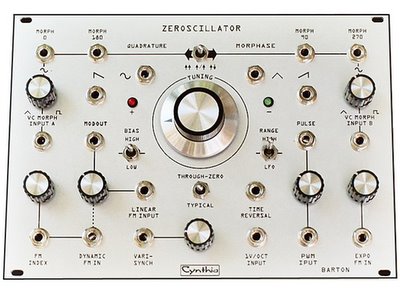John Bowen recently posted the following on AH. I asked him if it would be ok for me to put it up as a post and he said yes. This is in regards to the the 1978 NAMM show and the birth of the Prophet 5 and 10. The Prophet 5 was the first fully programmable polyphonic synthesizer. Title link takes you to a shot of the Audities Foundation Prophet 10, which also came up on the thread (note the Prophet 10 label).
"The original Prophet was a 5 voice. Dave Smith thought to add the second
board (which was just another standard 5 voice board mounted above the
first) as an option, but the synth shown at that 1978 NAMM was a 5
voice, which Dave had barely gotten working earlier that morning (after
working on it almost nonstop the days & nights leading up to the show).
I was at the booth at 10 am as we opened the show, and somehow word had
gotten out about the possibility of us having a programmable
polysynth...we had most all the major manufacturers represented there,
right when the show opened, asking about it. We didn't know what time
Dave was going to show up, and tried to stay mum about the product,
while more and more people showed up. Some time after noon, Dave arrived
with the Prophet under his arm, and we cleared a space for it. He had to
do some quick tweaks and checks, and when he powered it up, it worked
right away (but was pretty badly out-of-tune).
As Michael says, we had enough orders after the show ended to feel great
about the Prophet 5's future, and took those orders to the banks to get
some investment capital to build them.
There were a few persons who Dave had already been selling the Model 800
(sequencer) and Model 700 (programmer) to, one of them being Pat
Gleeson, and when he saw there was an option to have 10 voices, he
immediately order two in that configuration. Dave hadn't really tested
the heat issue with the boards layered, but the first several Prophet
10s made soon proved obvious that there was a tuning instability
problem. After Dave looked further into the situation, he decided it was
not going to be a viable option, so we did recall them. I seem to
remember there were 6 in total sent out, and I the one at Korg R&D was
the only semi-functional one still around (however, there is now someone
doing restoration work on a different single manual P-10 for a museum).
But there was no 'desperate measure' requiring removal of one of the
boards, nor a change of the name...it was always a Prophet 5, and if the
optional 5 voices were to be added, a different sticker was made for the
front panel. Simply an option that didn't work out.
regards,
John Bowen"

Tuesday, December 13, 2005
The Ultimate ARP Odyssey Page
Quantum Wave
Can't find or afford a Waldorf Wave? Well, you might want to check out the Quantum Wave, John Bowen's most recent emulation. Title link takes you there.

Update: A little more info from the site: "originally a custom project for Hans Zimmer, it is based on the functional design of the Waldorf Wave, using the Creamware Waldorf oscillators and the LP filter from the Pro One emulation (with an additional 12 dB HP filter). It is structured as a 4-part synth, meaning there are 4 individual synths inside the device (this being my first multi-timbre synth project). Potential customers should note that the Creamware version of the Waldorf oscillator does not produce the same quality of aliasing as the original, and therefore you should not expect the Quantum Wave to produce a faithful emulation of the Wave's sound."

Update: A little more info from the site: "originally a custom project for Hans Zimmer, it is based on the functional design of the Waldorf Wave, using the Creamware Waldorf oscillators and the LP filter from the Pro One emulation (with an additional 12 dB HP filter). It is structured as a 4-part synth, meaning there are 4 individual synths inside the device (this being my first multi-timbre synth project). Potential customers should note that the Creamware version of the Waldorf oscillator does not produce the same quality of aliasing as the original, and therefore you should not expect the Quantum Wave to produce a faithful emulation of the Wave's sound."
The Moog Cookbook
J-chot is on a mission to spread The Moog Cookbook goodness. He sent me a few good links below. If you haven't heard of them, and you are a synth fan, they are definitely worth checking out. They did a number of covers including modern and classic rock all with classic analogs and a couple of classic digitals including the DKS Synergy and... The Con Brio ADS200! To give perspective on this, according to the New England Synthesizer Museum there were only three Con Brio ADS200s manufactured and only one sold. Think about that... Move over GX1.
According to the last news (2000) posted on Moog Cookbook site (title link), the duo have been keeping busy doing some remixes for others, working with Beck and playing with AIR. Apparently they are in bits of a documentary titled, "Eating Sleeping Waiting Playing" featuring AIR. Pay attention folks, lots of nuggets worth checking out in this post and these sites.
J-chot's favorite shot of them (yep, that is one cool shot).

J-chot:
"can't BELIEVE you guys haven't done a piece on my favorite electronic band the moog cookbook! They were a two piece keyboard group band that did covers of songs in the late 90's with nothing but an array of beautiful vintage synthesizers. They made two AMAZING albums and then disappeared without a trace. Inside the cover booklet of each album was a list of all the synths they used on each song! I SUPER reccomend that you buy these albums. their live shows were supposed to be amazing as each of them were supposedly keyboard wizards. and guess what else? they were big in japan! I'm not surprised at all... It's sad that they disapeared though... they do an AMAZING cover/remix of Air's "Kelly watch the stars" if you can find it.. (oh trust me it's worth the search)
My fav pic of them: http://members.aol.com/mellot/pic2.jpg
Home page: http://hometown.aol.com/mellot/mcb.html
ALbums: http://www.amazon.com/exec/obidos/tg/stores/artist/glance/-/82307/102-5163645-7448110
some of their GEAR: http://hometown.aol.com/mellot/brikeys.html
more gearand band pics: http://hometown.aol.com/mellot/photos.html
here's a little piece by the synth museum: http://www.synthmuseum.com/mc/
here's a music video: http://www.musicvideocodes.com/?artist=6559
there's other little bits and pieces floating around.... but you NEED to educate the world about The Moog Cookbook! [consider it done!] : )
J-chot"
According to the last news (2000) posted on Moog Cookbook site (title link), the duo have been keeping busy doing some remixes for others, working with Beck and playing with AIR. Apparently they are in bits of a documentary titled, "Eating Sleeping Waiting Playing" featuring AIR. Pay attention folks, lots of nuggets worth checking out in this post and these sites.
J-chot's favorite shot of them (yep, that is one cool shot).

J-chot:
"can't BELIEVE you guys haven't done a piece on my favorite electronic band the moog cookbook! They were a two piece keyboard group band that did covers of songs in the late 90's with nothing but an array of beautiful vintage synthesizers. They made two AMAZING albums and then disappeared without a trace. Inside the cover booklet of each album was a list of all the synths they used on each song! I SUPER reccomend that you buy these albums. their live shows were supposed to be amazing as each of them were supposedly keyboard wizards. and guess what else? they were big in japan! I'm not surprised at all... It's sad that they disapeared though... they do an AMAZING cover/remix of Air's "Kelly watch the stars" if you can find it.. (oh trust me it's worth the search)
My fav pic of them: http://members.aol.com/mellot/pic2.jpg
Home page: http://hometown.aol.com/mellot/mcb.html
ALbums: http://www.amazon.com/exec/obidos/tg/stores/artist/glance/-/82307/102-5163645-7448110
some of their GEAR: http://hometown.aol.com/mellot/brikeys.html
more gearand band pics: http://hometown.aol.com/mellot/photos.html
here's a little piece by the synth museum: http://www.synthmuseum.com/mc/
here's a music video: http://www.musicvideocodes.com/?artist=6559
there's other little bits and pieces floating around.... but you NEED to educate the world about The Moog Cookbook! [consider it done!] : )
J-chot"
Lostsignal825's "Skinmatic"
Nice! Anyone know what this is a schematic for?
Via this post on Moogulator's Machinesound.de.

Update via the comments. : )
"thats not a schematic, it's a circuit trace. If it is done in electricly conducting ink the tatoo just needs to have components attached to form a working circuit, except for the fact that the body is a conductor (no insulation between traces) so the circuit won't actualy work. wonder if this person has a MIDI jack in their ass.."
Via this post on Moogulator's Machinesound.de.

Update via the comments. : )
"thats not a schematic, it's a circuit trace. If it is done in electricly conducting ink the tatoo just needs to have components attached to form a working circuit, except for the fact that the body is a conductor (no insulation between traces) so the circuit won't actualy work. wonder if this person has a MIDI jack in their ass.."
Monday, December 12, 2005
Euro-Rack Format Zeroscillator
Wow. This is absolutely stunning. Title link takes you to the Cynthia website with shots of all supported formats inlcuding MOTM, Blacet, DotCom, Modcan, and of course, this beauty, the Euro-Rack format.
Also check out the Cyndusties list for samples and more.

Also check out the Cyndusties list for samples and more.

John Bowen Synth Design & Zarg Music

I was just checking out John Bowen's Zargmusic site and I thought I'd put up a post on it. I remembered reading about John Bowen being part of Sequential Circuits, but I had no idea how large the scope of his contributions to the synth world were.
He started as the first official Moog clinician in 1973 and later joined Dave Smith and Sequential Circuits in 1976. He is the man behind the original 40 Prophet 5 presets and he was SCI's Product Specialist creating 99% of factory sounds for nearly all of the SCI product line. He contributed to the design of SCI instruments. After SCI was bought out by Yamaha, he moved on to Korg where he became the Product Manager for the Wavestation synths, followed by the OASYS project the Z1, and the OASYS PCI. After Korg he joined Creamware and worked on a number of projects including Pulsar/SCOPE and the Pro One and Prophet 5 emulations. Via Zarg Music John has released number of synths including the acclaimed Solaris and the Red Dwarf synths.
An interesting tidbit of trivia according to the history page on Zarg Music is that John Bowen coined both the terms "wave sequencing" and "multitimbre." The basic concepts behind wave sequencing also come from John. Fascinating bit of synth history.
Title link takes you to the Zargmusic site with more. Be sure to check out the history page and samples of each synth. If you haven't checked out the Red Dwarf, make sure to do so. It's a semi-modular with a number of interesting modules including a CEM Oscs-Pair, Waldorf OSC, WaveTable Osc-Modular, CEM LP 24 dB Filter and much, much more.
Wearable Synthesis

Via Synthtopia News. Title link takes you there. "This conceptual model is similar to the analog synthesizer. In analog synthesizer, users can generate infinite original sound by connecting and tuning three modules, VCA, VCO and VCF. We have named our model “Wearable Synthesis” in the meaning of enabling original fashion expression by combining individual fashion items."
PREVIOUS PAGE
NEXT PAGE
HOME













© Matrixsynth - All posts are presented here for informative, historical and educative purposes as applicable within fair use.
MATRIXSYNTH is supported by affiliate links that use cookies to track clickthroughs and sales. See the privacy policy for details.
MATRIXSYNTH - EVERYTHING SYNTH













© Matrixsynth - All posts are presented here for informative, historical and educative purposes as applicable within fair use.
MATRIXSYNTH is supported by affiliate links that use cookies to track clickthroughs and sales. See the privacy policy for details.
MATRIXSYNTH - EVERYTHING SYNTH






























